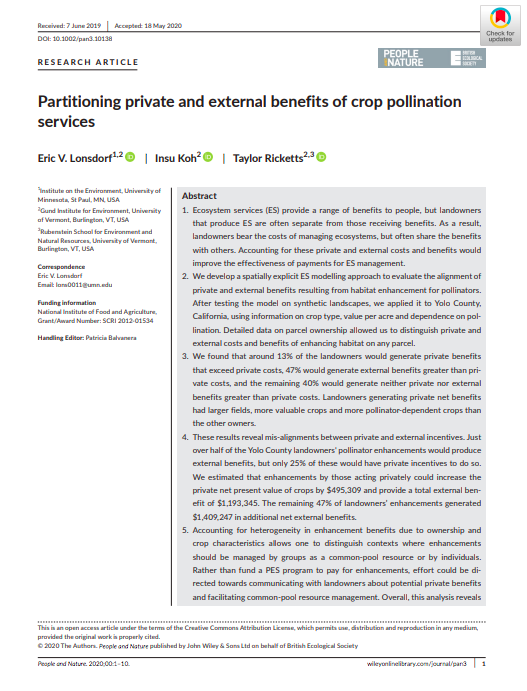Partitioning private and external benefits of crop pollination services

ABSTRACT
Ecosystem services (ES) provide a range of benefits to people, but landowners that produce ES are often separate from those receiving benefits. As a result, landowners bear the costs of managing ecosystems, but often share the benefits with others. Accounting for these private and external costs and benefits would improve the effectiveness of payments for ES management.
We develop a spatially explicit ES modelling approach to evaluate the alignment of private and external benefits resulting from habitat enhancement for pollinators. After testing the model on synthetic landscapes, we applied it to Yolo County, California, using information on crop type, value per acre and dependence on pollination. Detailed data on parcel ownership allowed us to distinguish private and external costs and benefits of enhancing habitat on any parcel.
We found that around 13% of the landowners would generate private benefits that exceed private costs, 47% would generate external benefits greater than private costs, and the remaining 40% would generate neither private nor external benefits greater than private costs. Landowners generating private net benefits had larger fields, more valuable crops and more pollinator‐dependent crops than the other owners.
These results reveal mis‐alignments between private and external incentives. Just over half of the Yolo County landowners’ pollinator enhancements would produce external benefits, but only 25% of these would have private incentives to do so. We estimated that enhancements by those acting privately could increase the private net present value of crops by $495,309 and provide a total external benefit of $1,193,345. The remaining 47% of landowners’ enhancements generated $1,409,247 in additional net external benefits.
Accounting for heterogeneity in enhancement benefits due to ownership and crop characteristics allows one to distinguish contexts where enhancements should be managed by groups as a common‐pool resource or by individuals. Rather than fund a PES program to pay for enhancements, effort could be directed towards communicating with landowners about potential private benefits and facilitating common‐pool resource management. Overall, this analysis reveals the importance of partitioning private and external benefits of actions designed to provide ES.